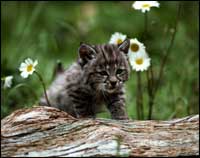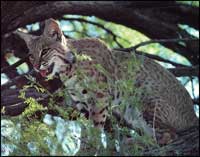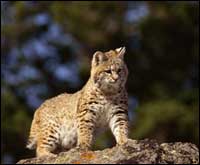Bobcats
While other native wild cat species are struggling to survive in Texas, the bobcat's secretive nature, highly developed physical capabilities, and ability to adapt to changing conditions have allowed it to thrive. It can be found throughout the state and is especially abundant in the South Texas brush country. However, its shy nature and the fact that it is most active at night keep it from being seen by most people. One way to tell if a bobcat is in the area is by the scratches on tree trunks where the cat sharpens its claws and the climbing scratches on frequently used lookout trees.

Young bobcats – well furred and spotted – usually are born in April.
Biologists recognize two subspecies of bobcats in Texas – the desert bobcat found in the west and northwest part of the state and the Texas bobcat, which ranges over the rest of the state – but they are so similar that it takes an expert to tell them apart. Generally speaking, a bobcat is about twice the size of a domestic cat. It has a larger bone structure, especially in the legs and head, and it is more muscular and better adapted for springing. It also has a deeper jaw that allows its mouth to open wider. Its ears are prominent, pointed, and tipped with ear tufts of black hair that assist in collecting sound to improve its hearing. Just how these hairs help with sound reception is not clear, but removing them will make a difference. A ruff of cheek fur extends from the side of its face, and it has long white whiskers.
Adult bobcats are usually twenty-five to thirty inches long, stand fifteen to twenty inches tall at the shoulder, and weigh between fifteen and twenty-five pounds. They have a short tail about six inches long. The male and female look alike, but the male will be larger. Occasionally a large male in the thirty- to thirty-five-pound class will be found. Color varies among the cats, but as a rule the bobcat is a cream-buff shade with tones of gray and brown, mottled with spots. Some cats may have more gray and others more brown. The lighter belly area is spotted. (Even though the bobcat is not classified as a furbearer, its dense, short, soft fur is marketed. The taking of bobcat pelts by trappers is strictly regulated in Texas, and information collected from harvested cats is used in research studies.) Enemies of adult bobcats include mountain lions, coyotes, and humans. Coyotes also compete with bobcats for food, since they both eat the same prey species.
Excellent eyesight is one of the physical capabilities that allow the bobcat to survive. Its pupils close to thin vertical slits to reduce bright sun-light during the day, and they open wide, covering most of the eyeball, to let in the maximum amount of light at night. The sensitive eyes are protected vertically with eyelids and horizontally with a thin covering called a nictitating membrane. The nictitating membrane, connected to the inside corner of the eye, moves across the eye from one side to the other beneath the eyelid.

Bobcats, agile animals, use lookout trees to survey their territories, and may sometimes be spotted on a branch during the day.
For good day and night vision an animal such as the bobcat must have an abundance of both rods (light receptors) and cones (color receptors) in its eyes. The cones allow it to distinguish color, see fine details, and detect movement. The rods respond to changes in light intensity and add to its ability to see at night. The combination allows the bobcat to lie motionless and see the slightest movement even in low-light conditions. Being able to see the twitch of a field mouse's nose at dusk or in the pre-dawn light can mean the difference between eating and going hungry. Night vision also is improved by a special mirrorlike membrane called the tapetum (ta-PEA-tum), located behind the image surface (retina) of the bobcat's eye. This membrane reflects light, allowing these night hunters to use low light twice, once on the way in and again on the way out. This reflected light is called eyeshine, and it is what makes some animals' eyes seem to glow in the dark.
Bobcats can live in a wide variety of habitats, including swamps, deserts, and mountain ranges, and they feed on different sizes of prey – small (mice), medium (rabbits and poultry), and large (domestic animals and deer). Their predation on deer is a controversial subject. Although studies have shown that most of the deer found in bobcat stomachs is carrion, an adult bobcat is strong enough to bring down an adult deer. Its usual method of attack is to jump on the deer's back from a ledge and bite the base of the deer's skull while tearing and slashing with its claws. When the deer drops, the bobcat pulverizes its throat in seconds with fast, strong bites. If a bobcat comes across a fawn, it will not hesitate to make a meal of it. When a bobcat kills more than it can eat at one time, it covers the remains with leaves or other debris and then comes back to finish it later. If a bobcat comes across another cat's cache, it will help itself.
The bobcat also hunts by a method in which it stops, sits, and waits for prey. These waiting spots are called lookouts and hunting beds. As the bobcat crouches and waits, it slowly rotates so it can watch the area all around it. This action results in a circular "bed" with paw prints around the edge. The bobcat also depends on sight and hearing to locate smaller prey, moves as close as possible without being seen, and then makes a short dash to capture it.

Bobcats' shy nature and nocturnal habitats keep most people from seeing them.
Bobcats are solitary animals and do most of their hunting at night. The range varies with food abundance and may cover as much as fifty miles or as little as five. When rodent and rabbit populations are high, a bobcat may travel only half a mile a day while feeding. Females seldom overlap the ranges of other females, but they do overlap those of males. Male ranges overlap more often since they have much larger ranges than the females. Both sexes are usually tolerant of transient juvenile bobcats moving through their territories. In fact, bobcats seem to try to avoid running into each other except during the mating season.
Breeding usually begins in February, and about fifty days later the young are born in dens located in caves and crevices or under logs, barns, or sheds. Litter size may vary from two to seven, but two is most common. The blind young are well-furred and spotted at birth and they begin to suckle immediately. They weigh about ten to twelve ounces. Their eyes open in about nine days. The mother has the responsibility of raising them, and she defends them from all predators, including male bobcats. By the time they are a month old, they are learning to walk with agility, and solid food is being added to their diet. They are weaned when they are about two months old. If the mother can keep them fed and hidden from humans, they probably will survive. The young remain with their mother until early fall, and then they must strike out on their own. Young females will be ready to breed when they are about a year old. The males mature during their second year, and the cycle begins again.
Ilo
Hiller
1990 – Bobcats: Introducing Mammals to
Young Naturalists. The Louise
Lindsey Merrick Texas Environment
Series, No. 10, pp. 21-25.
Texas A&M University
Press, College Station.